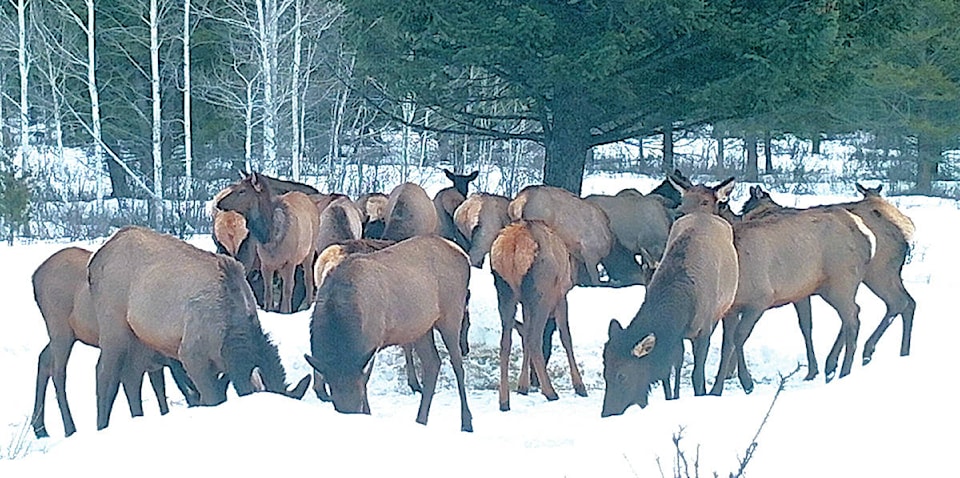Ray Demarchi
Elk numbers in the East Kootenay have declined in recent years for reasons that are mainly habitat related.
Of the seven species of wild ungulates in the East Kootenay, elk are the most responsive to supplemental winter feeding — a valid management tool in the maintenance and production of elk that is practiced throughout much of the species’ range in North America and Europe where it has been conducted for centuries.
Despite this, following the harsh winter of 2016–17, the Ministry of Forests, Lands and Natural Resource Operations and Rural Development (FLNRORD) issued a ‘Fact Sheet’ warning of the ‘harm’ caused by feeding of elk and deer during winter. Rather than presenting a balanced view that includes the benefits and successes of a properly designed and implemented feeding program, the sheet focused on all that can go wrong with wildlife feeding programs.
Elk numbers in the East Kootenay have always fluctuated in response to environmental extremes but lately the trend has been steadily downward. This decline is largely the result of the replacement of productive shrub/grassland winter foraging areas in the East Kootenay Trench with conifer trees due to more than half a century of vigorous forest fire suppression. This factor coupled with harsh winters with deep (and sometimes crusted) snow and cold temperatures have reduced the availability of nutritious feed and increased energy expenditures as animals work harder to stay warm and move about. This can mean a decline in body condition leading to increased predation, terminated pregnancies, and starvation – all of which serve to reduce the population. On-the-ground management actions can be the difference between life or death, and population growth or decline.
The East Kootenay has a history of supplemental winter elk feeding. In response to low elk numbers and high hunter demand, beginning in the winter of 1973–74, the provincial government funded a feeding program for five winters during which hay was placed regularly at some 20 feeding sites in the East Kootenay Trench. Two years after supplemental winter elk feeding was started, a program referred to as Coordinated Resource Management Planning (CRMP) was applied to the Trench’s Range Management Units which improved forage production and quality for both elk and cattle. In response to the feeding program, elk productivity reached as high as 70 calves per 100 cows in mid-winter – more than double the pre-feeding estimate. The end result of several years of increased survival and calf production was a quadrupling of elk numbers by the end of 1978 – the last year of the government feeding program. Thereafter, for nearly 20 years, the benefits of CRMP and a series of mild winters reduced or eliminated the need to feed elk.
Among several potential negative effects, FLNROD’s fact sheet stated that concentrating animals on feeding sites puts them at risk of digestive ailments and chronic wasting disease (which has never been recorded in BC). It also warns that such feeding programs can cause damage to fragile soils and alter rangelands via the introduction of weeds whose seeds occur in the hay. All of these risks, whether real or perceived, can be mitigated or avoided by applying science and management experience.
Although rapid changes in diet can harm an elk’s digestive system, in the five years the supplemental feeding program was conducted in the East Kootenay by the Wildlife Branch and in the several years, including last winter, when elk were fed by citizen volunteers, the number of elk observed either in distress or dead from digestive ailments was negligible. This observation has been borne out for elk feeding with cows and horses at winter feeding sites on many of the more than 120 cattle ranches in the East Kootenay since cattle and elk first coexisted in the East Kootenay over 100 years ago.
As for the “trampling of fragile soils” or the “introduction of invasive plant species” the adverse affects of feeding elk on frozen, snow covered ground and introducing weed seeds in fed hay is insignificant compared to extensive post-wildfire aerial grass seeding, logging on wet ground or excessive grazing by cattle —all activities overseen by FLNRORD itself.
I agree that a supplemental feeding program could cause harm or unintended consequences if it did not conform to well-known best practices. Yet, to ignore the success of not only the local experience, but the large-scale elk feeding programs undertaken in the United States and Europe is shortsighted.
The East Kootenay elk population harbours significant potential for economic and social benefits that could once again be realized if coordinated efforts were taken to restore it. But this requires active rather than passive management—in other words, we need to go beyond simply setting and enforcing hunting regulations and discouraging those who are willing to pitch-in and make a difference.
When conducted properly, supplemental feeding to maintain or bolster herd productivity in the face of harsh winters is a valid management tool. Rather than simply dismissing or discouraging supplemental winter feeding, FLNRORD should acknowledge that such a program can play an important role in restoring elk numbers. A supplemental feeding program that (i) is based on science and managerial experience, (ii) harnesses the dedication and in-kind services of volunteers who are gladly willing to work for the sake of elk conservation, and (iii) is endorsed by FLNRORD can, in my experience, lead only to success. If conducted in concert with the reintroduction of Coordinated Resource Management Planning on the East Kootenay Trench’s publicly owned forest and rangelands, the future of elk would be bright indeed.
Ray Demarchi, is the retired B.C. Chief of Wildlife Conservation and served as Wildlife Section Head for Kootenay Region from 1964 to 1992.
